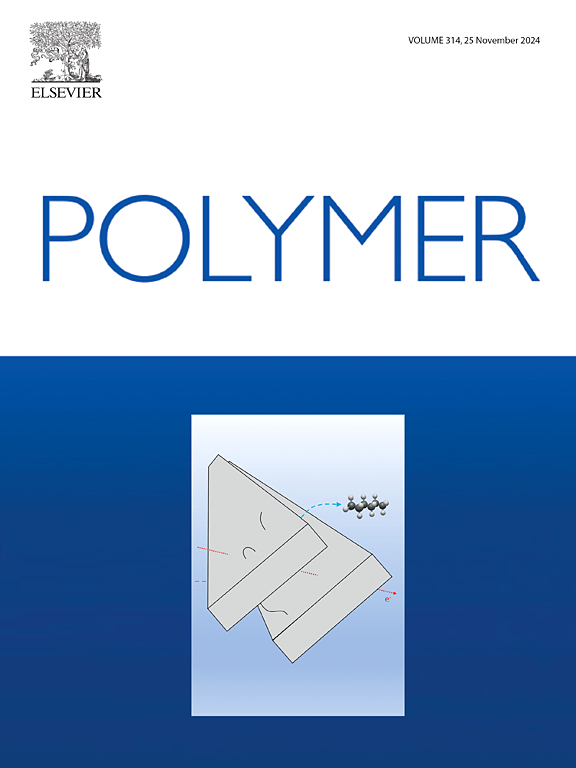Reinforcement and toughening mechanisms of ionic clusters in ethylene-propylene-diene monomer rubber
IF 4.1
2区 化学
Q2 POLYMER SCIENCE
引用次数: 0
Abstract
Zinc methacrylate (ZDMA) is widely used for reinforcing and toughening non-polar rubbers due to its ability to graft onto the rubber chains and form ionic clusters. However, the specific mechanisms by which these ionic clusters enhance the mechanical properties of rubbers remain to be fully elucidated. In this paper, the reinforcement and toughening effects of ZDMA in an ethylene-propylene-diene monomer (EPDM) rubber were systematically investigated. By adjusting the contents of ZDMA and bis(tert-butyldioxyisopropyl) benzene (BIPB), the tensile strength of ZDMA-modified EPDM vulcanizate at 20 °C increased from 21.70 MPa to 33.66 MPa, while the toughness improved from 24.29 MJ m−3 to 48.96 MJ m−3. The results demonstrated that the ionic cross-linking and strain amplification effects introduced by the ionic clusters were the primary causes for the significantly improved strength and toughness. Notably, it was found that the ionic cross-linking could be partially dissociated to promote homogeneous stress transfer and strain-induced crystallization (SIC) in the EPDM, which played a vital role in the rubber reinforcement and toughening. Overall, this study provides a comprehensive understanding of the reinforcement and toughening mechanism of ZDMA in EPDM, which is of great significance for the future research, development and application of reactive fillers in non-polar rubbers.


离子团簇在乙丙二烯单体橡胶中的增强和增韧机理
甲基丙烯酸锌(ZDMA)被广泛用于增强和增韧非极性橡胶,因为它能够接枝到橡胶链上并形成离子团簇。然而,这些离子团簇增强橡胶机械性能的具体机制仍有待充分阐明。本文系统地研究了ZDMA在三元乙丙橡胶中的增强增韧作用。通过调节ZDMA和双叔丁基二氧异丙基苯(BIPB)的含量,ZDMA改性EPDM硫化胶在20℃时的拉伸强度由21.70 MPa提高到33.66 MPa,韧性由24.29 MJ·m-3提高到48.96 MJ·m-3。结果表明,离子交联和离子团簇引入的应变放大效应是导致强度和韧性显著提高的主要原因。值得注意的是,离子交联可以部分解离,促进EPDM中的均匀应力传递和应变诱导结晶(SIC),这在橡胶的增强和增韧中起着至关重要的作用。总体而言,本研究全面了解了ZDMA在EPDM中的补强增韧机理,对今后非极性橡胶中反应性填料的研究、开发和应用具有重要意义。
本文章由计算机程序翻译,如有差异,请以英文原文为准。
求助全文
约1分钟内获得全文
求助全文
来源期刊

Polymer
化学-高分子科学
CiteScore
7.90
自引率
8.70%
发文量
959
审稿时长
32 days
期刊介绍:
Polymer is an interdisciplinary journal dedicated to publishing innovative and significant advances in Polymer Physics, Chemistry and Technology. We welcome submissions on polymer hybrids, nanocomposites, characterisation and self-assembly. Polymer also publishes work on the technological application of polymers in energy and optoelectronics.
The main scope is covered but not limited to the following core areas:
Polymer Materials
Nanocomposites and hybrid nanomaterials
Polymer blends, films, fibres, networks and porous materials
Physical Characterization
Characterisation, modelling and simulation* of molecular and materials properties in bulk, solution, and thin films
Polymer Engineering
Advanced multiscale processing methods
Polymer Synthesis, Modification and Self-assembly
Including designer polymer architectures, mechanisms and kinetics, and supramolecular polymerization
Technological Applications
Polymers for energy generation and storage
Polymer membranes for separation technology
Polymers for opto- and microelectronics.
 求助内容:
求助内容: 应助结果提醒方式:
应助结果提醒方式:


